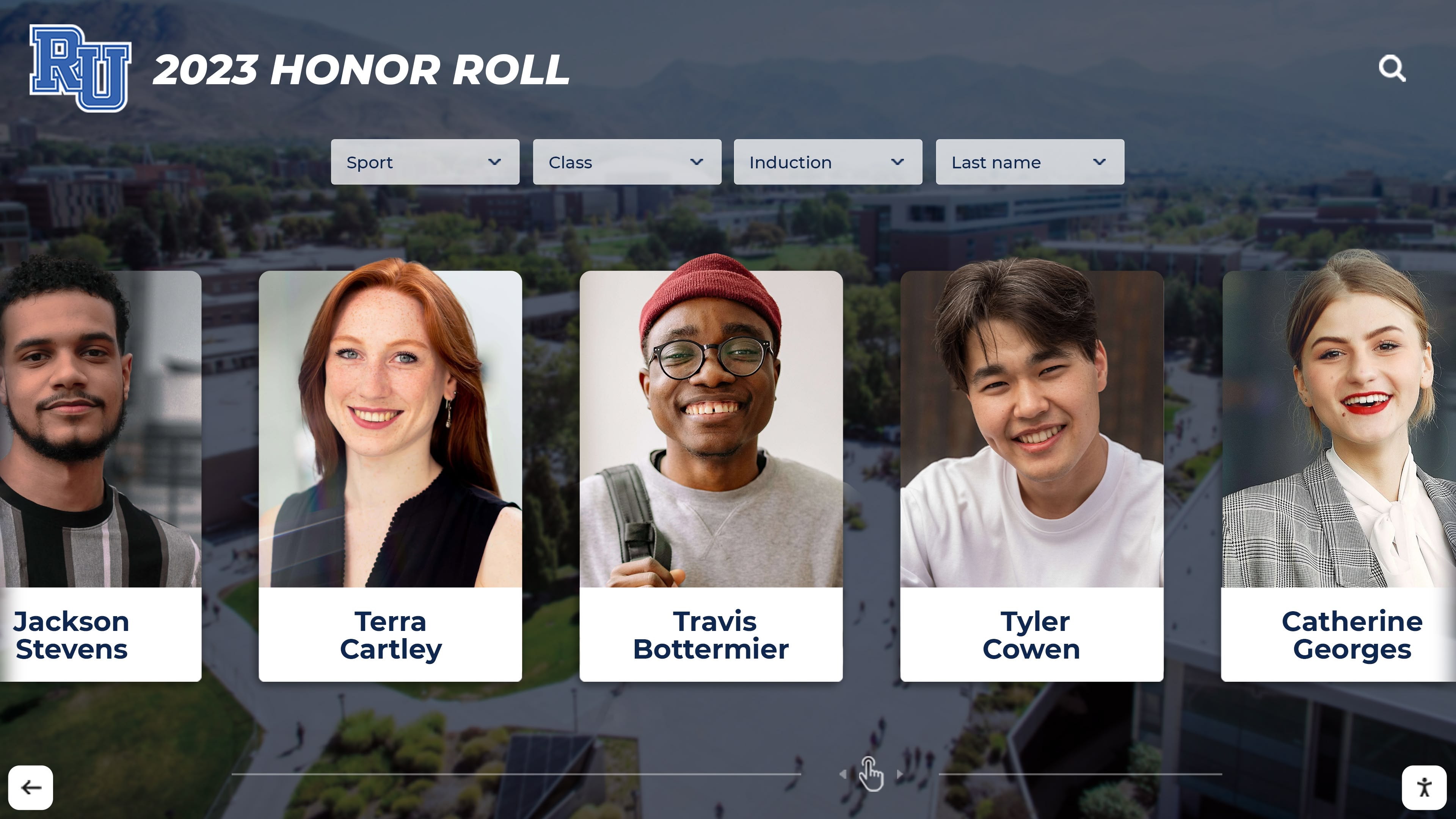Every educational institution understands that academic achievement deserves celebration, yet many schools struggle with recognition systems that feel outdated, exclusive, or ineffective. Traditional honor roll bulletin boards fade and tear, static plaques consume valuable wall space, and limited capacity forces difficult decisions about which accomplishments receive permanent acknowledgment. Meanwhile, research consistently shows that meaningful academic recognition increases student motivation by up to 40%, improves attendance, and strengthens school culture when implemented thoughtfully.
A scholastic wall of honor solves these fundamental challenges by creating comprehensive recognition systems celebrating academic excellence across all levels while preserving achievement history and inspiring current students. Whether implemented through traditional physical displays, innovative digital platforms, or strategic hybrid approaches, effective scholastic walls of honor transform one-time acknowledgments into lasting celebrations that motivate continued excellence while demonstrating that academic achievement receives the visibility and respect it deserves.
Why Scholastic Walls of Honor Transform Academic Culture
Modern scholastic walls of honor serve dual purposes that extend far beyond simple name recognition: they provide meaningful validation to students whose dedication and effort produce academic success, and they create powerful visual reminders that intellectual achievement matters as much as athletic accomplishment in school communities. Solutions like Rocket Alumni Solutions provide purpose-built platforms specifically designed for academic recognition, combining unlimited capacity with engaging presentation capabilities that traditional bulletin boards and plaques simply cannot match.
Understanding Scholastic Walls of Honor: Purpose and Impact
Before implementing recognition programs, understanding what makes scholastic walls of honor effective helps schools design systems that achieve intended goals while avoiding common pitfalls that undermine academic culture.
The Strategic Value of Academic Recognition
Scholastic walls of honor fulfill distinct functions within educational environments that other forms of acknowledgment cannot replicate. Unlike temporary certificates or brief assembly announcements, permanent walls of honor communicate that academic achievement merits lasting institutional celebration.
Motivation Through Visible Achievement: When students see comprehensive recognition of peers and predecessors who achieved academic excellence, they gain concrete understanding of what’s possible. A sophomore viewing honor roll displays understands exactly what level of performance earns permanent acknowledgment. This visibility transforms abstract concepts like “academic excellence” into tangible, achievable goals backed by evidence that dedication leads to recognition.
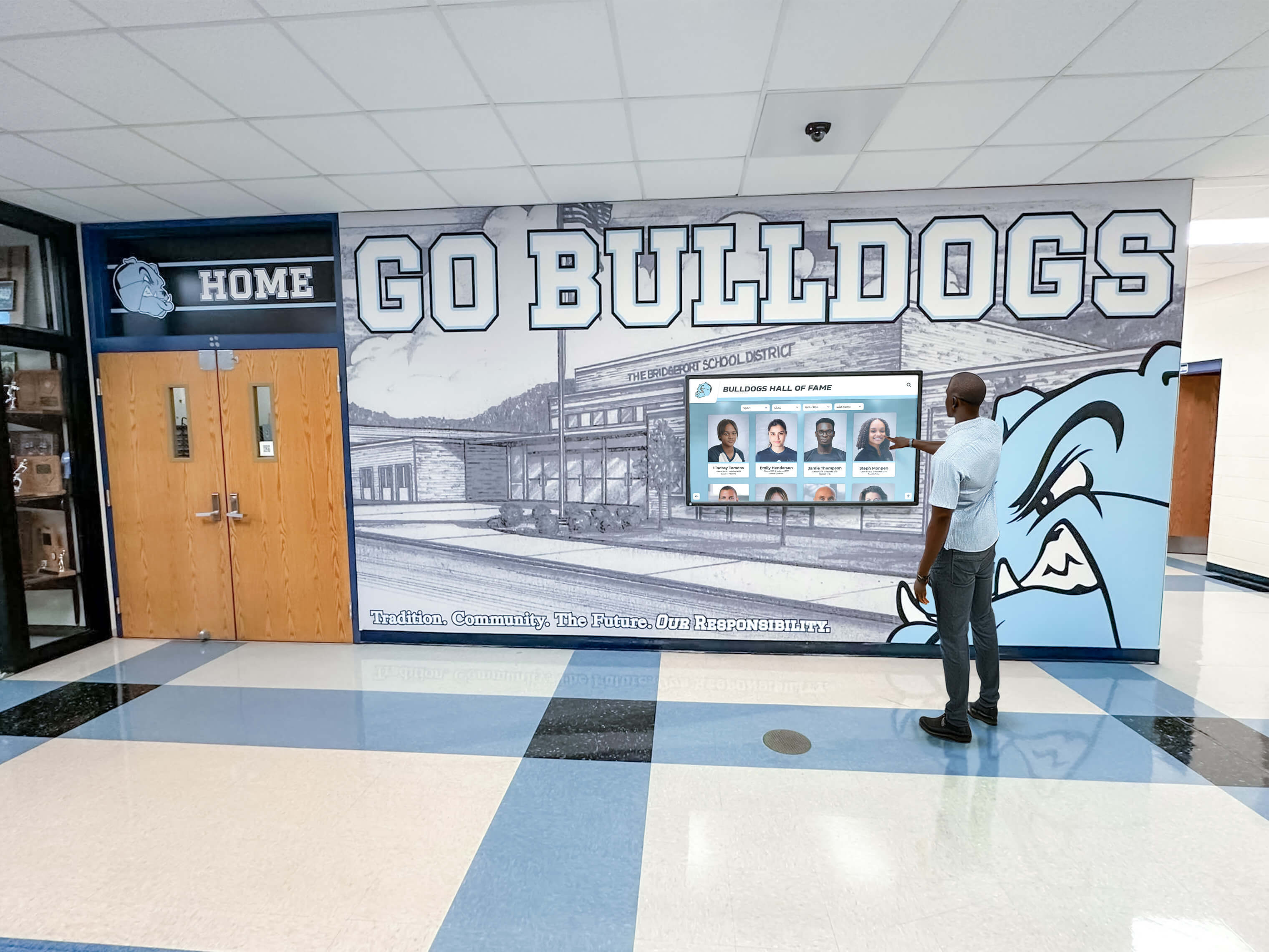
Historical Preservation of Academic Achievement: Schools generate rich academic histories through valedictorians, honor roll students, scholarship winners, and graduates who achieved remarkable success. Without systematic recognition, these achievements fade from institutional memory within a generation. Scholastic walls of honor preserve this history, creating connections between current students and the academic traditions they’re continuing.
Program Reputation and Recruitment Impact: Prospective students and families evaluating schools pay attention to visible evidence of academic excellence. A comprehensive scholastic wall of honor demonstrates depth of achievement and commitment to recognizing student success—messages that resonate with academically motivated individuals and their parents considering program options.
The Psychology Behind Academic Recognition
Understanding what drives recognition effectiveness helps institutions design scholastic walls that genuinely strengthen motivation rather than simply checking acknowledgment boxes. Research in educational psychology reveals that meaningful recognition addresses several core student needs:
Social Validation: Students appreciate public acknowledgment confirming that their academic efforts and achievements matter to communities they care about. Recognition creates visible affirmation that contributions represent valued participation in educational excellence.
Peer Influence and Aspiration: When students see classmates and older students recognized for academic achievement, it normalizes scholarly excellence as an achievable and socially valued goal. According to research from the National Education Association, 68% of students reported feeling more motivated when their achievements were displayed publicly.
Identity Formation: During formative years, recognition helps adolescents develop positive academic identities and confidence in their intellectual abilities. For students who struggle athletically or socially, academic recognition can be transformative—providing the positive feedback necessary for healthy identity development and school connection.
Growth Mindset Development: The most effective recognition explicitly connects achievements to the efforts and strategies that made them possible rather than attributing success to innate talent. This growth-oriented approach, supported by research from Stanford University’s Carol Dweck, encourages students to view intelligence and academic ability as developable through dedication rather than fixed traits beyond their control.
Core Benefits: Why Scholastic Walls of Honor Matter
Strategic academic recognition delivers measurable value across multiple educational priorities simultaneously, making investment in comprehensive scholastic walls among the highest-return initiatives schools can implement.
Dramatically Improved Student Motivation and Achievement
According to a 2024 study by the National Education Association, schools with comprehensive academic recognition displays experience significant positive effects. Research shows that public recognition boosts student engagement by up to 40%, while recognized students demonstrate measurably higher persistence toward academic goals.
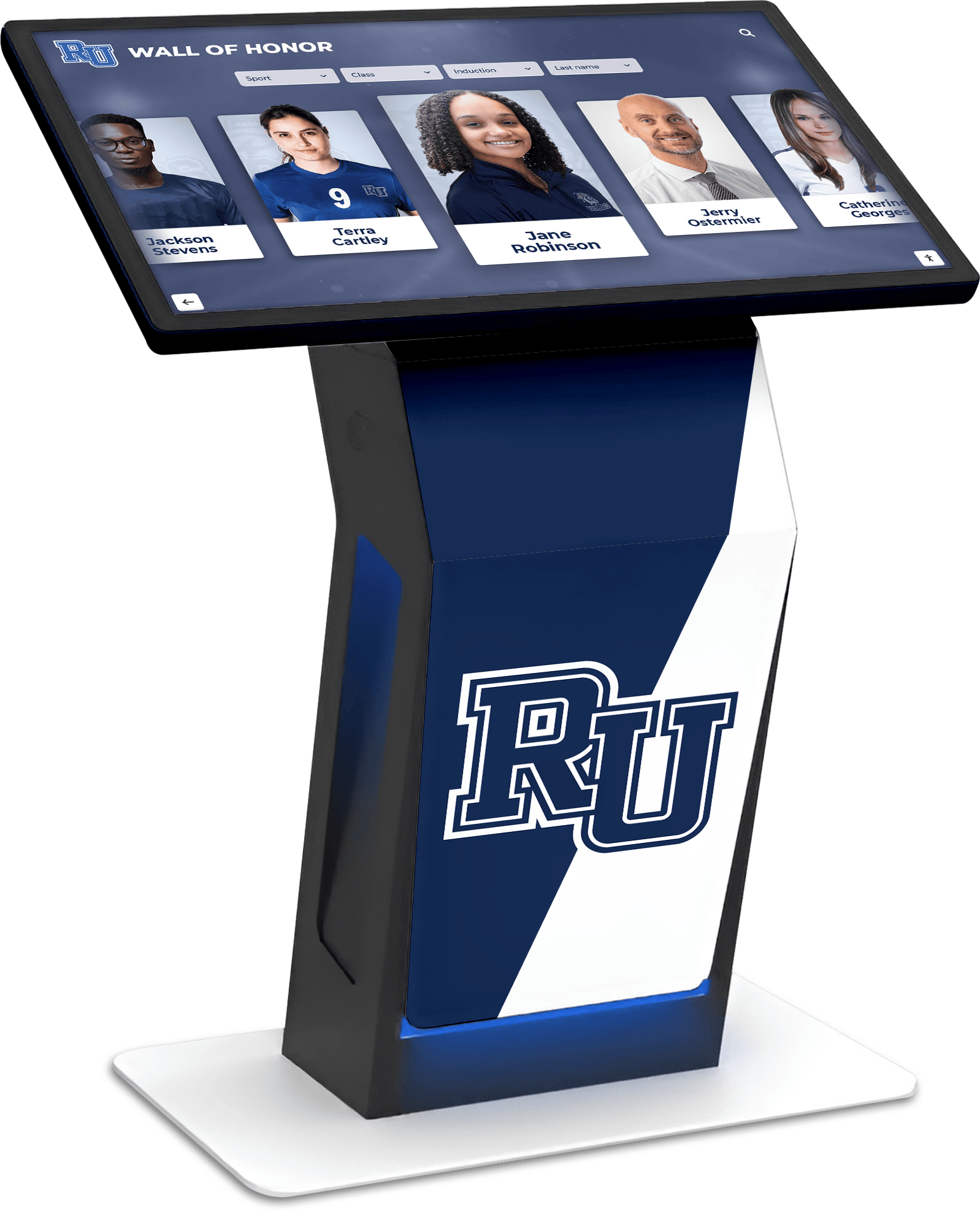
This dramatic improvement results from several factors working together. Immediate recognition satisfies students’ natural desire for acknowledgment when achievement motivation peaks, while ongoing visibility ensures students encounter their appreciation regularly rather than experiencing one-time certificates that quickly disappear into storage. Meaningful recognition demonstrates institutional values around academic excellence and intellectual growth, building confidence that the school treats scholarly achievement with appropriate respect.
Enhanced School Culture and Climate
Scholastic walls of honor contribute significantly to positive school culture by balancing recognition systems that often overemphasize athletic achievement while minimizing academic excellence. When schools provide academic recognition equal visibility and prestige to athletic recognition, they communicate authentic institutional priorities valuing intellectual development alongside physical accomplishment.
This balanced approach affects student behavior patterns, effort allocation, and fundamental perceptions about what the school community genuinely values. Students who previously felt their academic strengths went unnoticed develop stronger school connections. Families appreciate visible evidence that schools honor diverse forms of excellence. Teachers gain reinforcement for academic emphasis when recognition systems support their efforts to inspire scholarly achievement.
Inspiration for Younger Students
Recognition walls showcasing successful students who achieved academic excellence create powerful role models for younger students. When middle schoolers see high school honor roll displays or freshmen explore valedictorian histories, abstract concepts about academic achievement become concrete behavioral models with relatable peer examples.
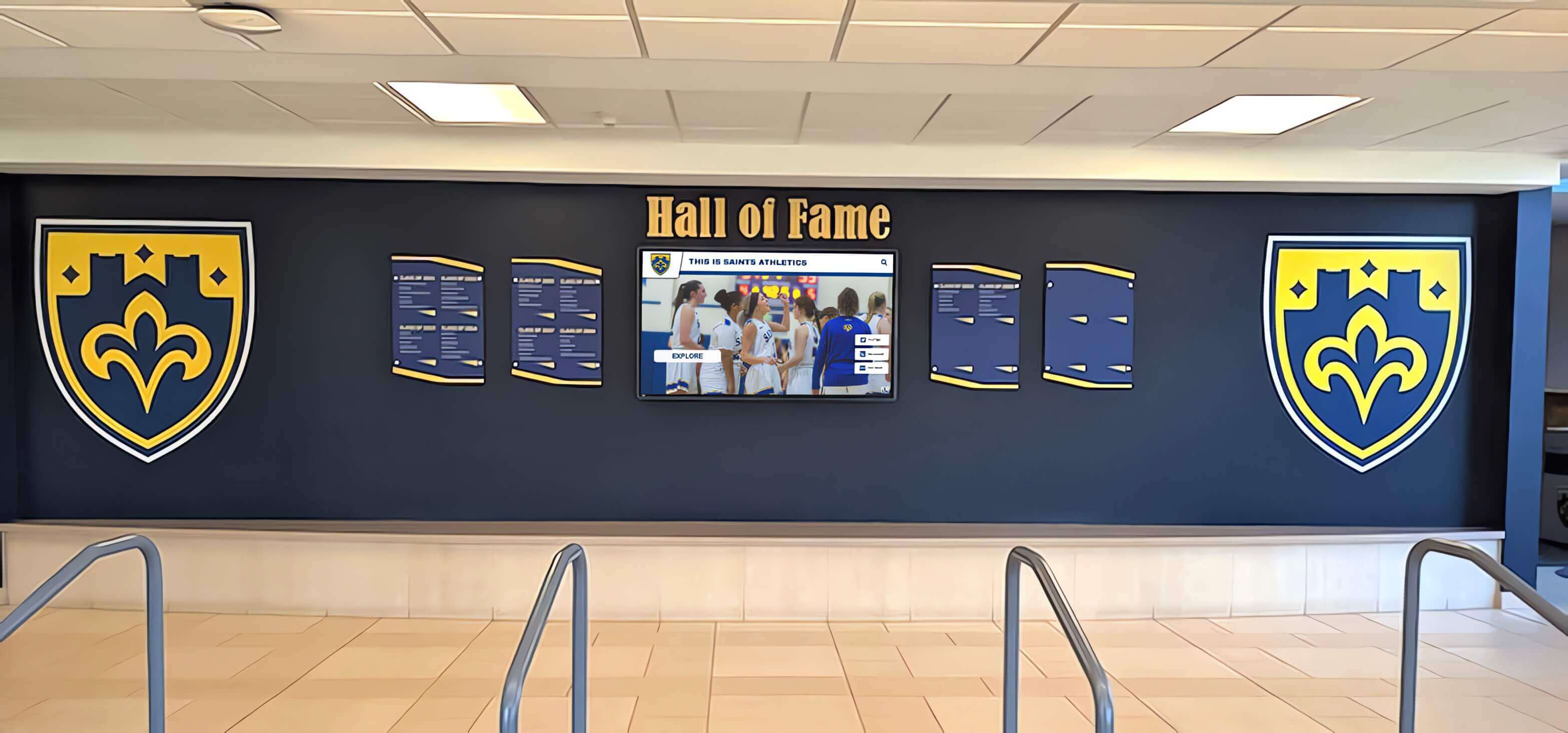
Young students particularly appreciate technology-enabled recognition aligning with their digital communication preferences. Generation Z and Generation Alpha students expect interactive engagement and visual presentation—all native to digital recognition systems but impossible with traditional paper-based approaches. When students photograph their recognition profiles and share to social media, they introduce academic excellence to hundreds of potential peers who trust recommendations from friends more than traditional school messaging.
Demonstrated Academic Program Quality
Modern families increasingly expect transparency demonstrating educational quality and student achievement outcomes. Effective scholastic walls address this expectation by explicitly showcasing academic program results through comprehensive recognition of honor students, scholarship winners, competitive successes, and college admission achievements.
This transparency serves multiple audiences simultaneously. Prospective families touring schools see concrete evidence of academic excellence. Current families gain reinforcement that they made sound educational choices. Community members develop pride in local school quality. Alumni maintain connections to institutions demonstrating continued academic strength.
Traditional vs Digital: Choosing the Right Approach
Schools planning new scholastic recognition systems or upgrading existing walls face strategic decisions about formats, technologies, and implementation approaches that significantly impact both immediate costs and long-term effectiveness.
Traditional Physical Recognition
Traditional scholastic walls featuring printed honor roll lists, engraved plaques, or name plates provide familiar acknowledgment that many schools have used successfully for generations.
Advantages:
- Tangible, permanent presence requiring no electricity or connectivity
- Familiar format aligned with long-standing institutional traditions
- Zero learning curve for students and families viewing recognition
- No ongoing technology costs or platform subscriptions
- Strong emotional resonance for traditionalist stakeholders
Limitations:
- Finite physical capacity creating inevitable space constraints
- High per-student costs for engraving and professional installation
- Update delays requiring production and physical mounting
- Limited information restricted to names, honors levels, and dates
- No interactivity, search functionality, or rich storytelling
- Geographic restriction to campus visitors only
- Deterioration over time requiring maintenance and eventual replacement
Digital Interactive Recognition
Modern digital scholastic walls transform how schools honor students by addressing every limitation of traditional approaches while introducing capabilities impossible with physical-only systems.
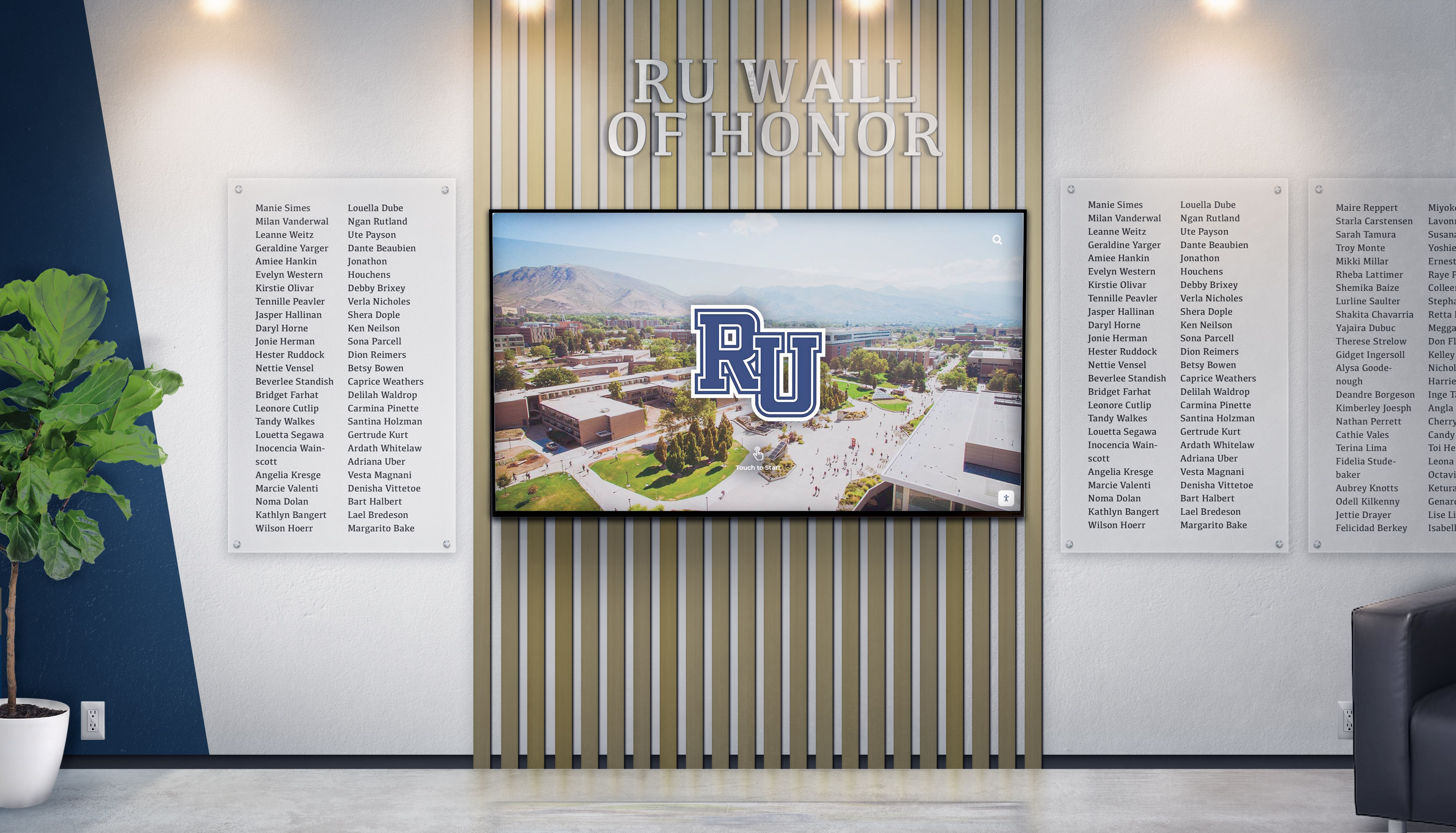
Advantages:
- Unlimited recognition capacity accommodating thousands of students
- Instant content updates without physical modifications
- Rich multimedia profiles featuring photos, achievement details, growth stories
- Powerful search enabling discovery by name, year, honor level, or achievement type
- Remote accessibility through web integration and mobile apps
- Comprehensive analytics tracking engagement and popular content
- Lower long-term costs compared to ongoing physical additions
- Dynamic content maintaining fresh, engaging displays
- Equal prominence for all recognized students without physical hierarchy
Limitations:
- Higher initial investment than basic printed lists ($8,000-$25,000 for comprehensive systems)
- Requires reliable electricity and network connectivity
- Needs content management processes for regular updates
- Some initial learning curve for less tech-comfortable visitors
- Potential resistance from traditionalist stakeholders
Cost Analysis: While digital systems require higher upfront investment, long-term cost comparisons favor technology-based approaches. Traditional recognition costs accumulate continuously—printing new honor roll lists quarterly ($200-$500), periodic wall expansions when space fills ($5,000-$20,000+), ongoing maintenance and replacement, and eventual complete renovations as displays age. Digital systems convert these unpredictable variable costs into manageable fixed annual subscriptions ($2,000-$5,000) covering unlimited student additions while providing vastly superior functionality.
Hybrid Approaches: Best of Both Worlds
Many successful implementations strategically combine selective traditional recognition with comprehensive digital systems, balancing symbolic permanence with practical functionality.
Effective hybrid strategies might include maintaining signature physical displays for highest academic honors (valedictorians, salutatorians, National Merit Scholars), adding digital recognition walls providing unlimited capacity for comprehensive honor roll recognition, integrating QR codes on physical plaques linking to expanded digital profiles, and ensuring web accessibility allowing remote families to explore recognition regardless of physical display format.
This balanced approach honors institutional traditions while solving capacity limitations through modern technology, respecting diverse stakeholder preferences while delivering recognition effectiveness that neither approach achieves independently.
Essential Features of Effective Scholastic Walls of Honor
Exceptional academic recognition systems share specific characteristics ensuring they serve educational objectives effectively across years and decades.
Comprehensive Achievement Categories
Well-designed scholastic walls organize students into clear achievement classifications that acknowledge academic accomplishment while maintaining dignity across all recognition levels.
Common Recognition Categories:
- Valedictorian and Salutatorian Recognition (highest academic achievement)
- Principal’s List (typically 4.0 GPA): Exceptional academic performance
- High Honor Roll (typically 3.5-3.99 GPA): Outstanding achievement demonstrating consistent excellence
- Honor Roll (typically 3.0-3.49 GPA): Strong performance and commendable academic dedication
- Academic Improvement Recognition: Significant growth and development regardless of absolute achievement level
- Subject-Specific Excellence: Outstanding performance in mathematics, science, English, social studies, world languages, or other disciplines
- Advanced Placement and Honors Recognition: Success in rigorous coursework demonstrating college readiness
- Perfect Attendance with Honor Roll: Combined recognition celebrating both academic achievement and consistent school engagement
- Academic Competition Success: Science fair, mathematics competitions, debate tournaments, spelling bees, and other intellectual contests
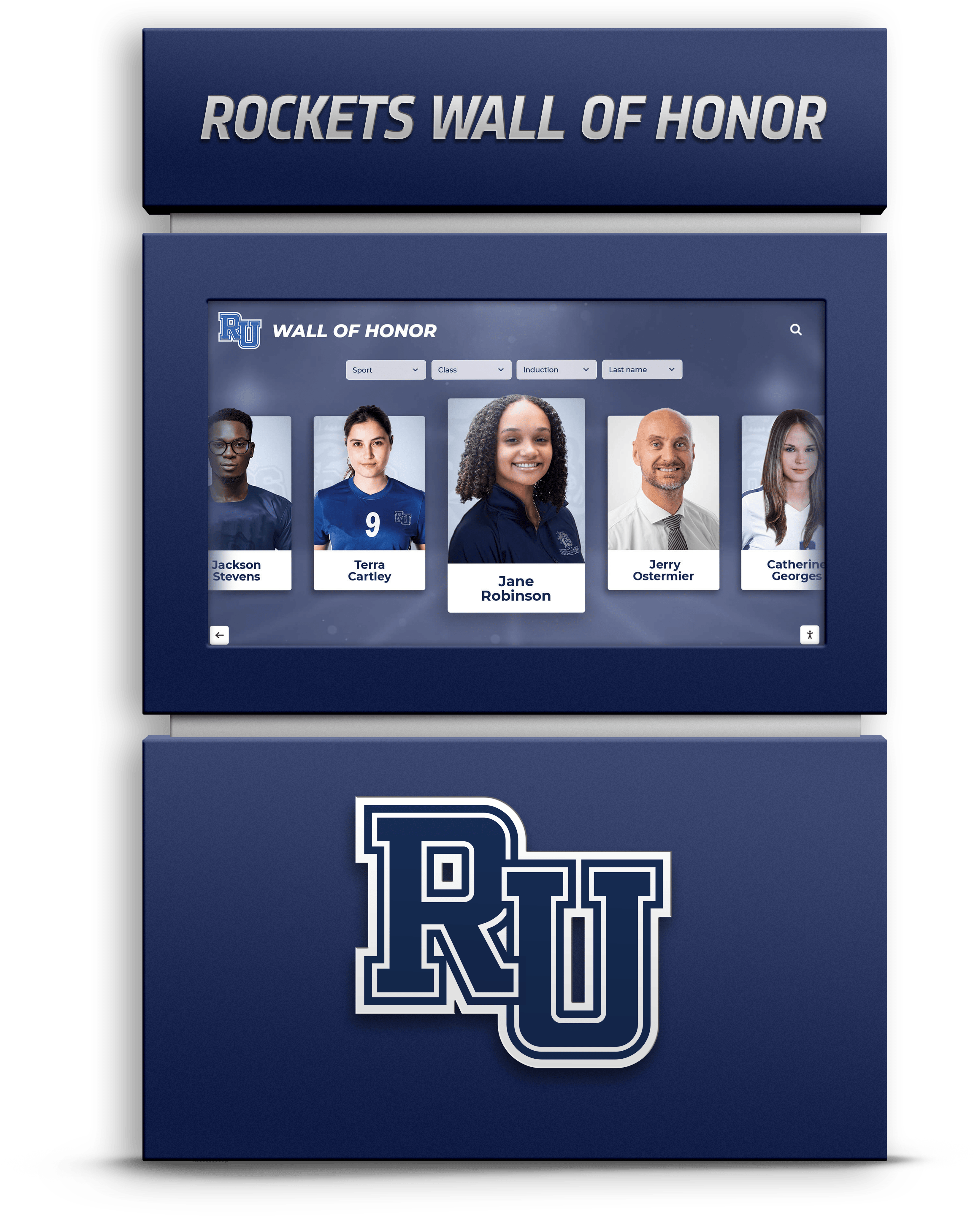
These thresholds should align with institutional context, student body characteristics, and educational philosophy. Some schools set higher thresholds for selective recognition while others create more inclusive categories ensuring broader student acknowledgment. Visual distinction between categories through color coding, display prominence, or enhanced content for higher achievement levels acknowledges accomplishment magnitude while ensuring all recognized students receive genuine appreciation.
Compelling Student Storytelling
Recognition value depends fundamentally on content quality and emotional resonance, not merely student name listings. The most effective systems tell complete stories about student dedication, growth, and achievement.
Profile Depth Elements:
- Student biography including graduation year and academic interests
- Specific honors achieved and recognition levels earned
- Grade point average or academic achievement metrics (when privacy allows)
- Course rigor information highlighting advanced placement, honors, or challenging curriculum
- Specific accomplishments like perfect attendance, academic competition success, or scholarship awards
- Personal reflections on study strategies, favorite subjects, or academic goals
- Messages to younger students offering encouragement or advice
- Photos showing students in academic settings, award ceremonies, or study environments
- Teacher nominations explaining why students earned recognition
Achievement Context: The most compelling recognition explicitly connects academic success to the efforts and strategies that produced results. Rather than simply listing GPAs, effective displays share how consistent study habits supported achievement, describe research projects or assignments that demonstrated excellence, document improvement journeys from lower performance to honor roll status, and showcase specific examples of intellectual growth or subject mastery.
This contextual storytelling transforms recognition from transactional acknowledgment into meaningful celebration that reinforces achievement decisions while inspiring others to consider similar dedication to academic excellence.
Intuitive Discovery and Navigation
Recognition serves no purpose if students cannot efficiently find relevant content. User experience design determines whether systems generate sustained engagement or become ignored institutional features.
Search Functionality: Digital scholastic walls should provide robust search capabilities including name search with partial matching and suggestions, graduation year or class filtering, honor level or achievement category filtering, subject-specific excellence search, and academic competition or award type organization.
Browsing Pathways: Beyond search, organized browsing enables casual exploration and serendipitous discovery through chronological timelines showing honor students by year or decade, category-based organization by honor level or achievement type, featured content rotation highlighting diverse students, and related profile suggestions encouraging extended exploration.
Mobile Optimization: With increasing mobile usage, recognition systems must deliver excellent experiences across all devices through responsive design adapting to any screen size, touch-optimized controls and navigation, fast loading on cellular connections, and social sharing integration for easy distribution.
Types of Academic Achievements Worth Recognizing
Comprehensive scholastic walls of honor celebrate diverse forms of academic excellence rather than narrow definitions focusing exclusively on GPA.
Honor Roll and Grade-Based Recognition
Traditional honor roll recognition remains foundational to academic programs, acknowledging students who achieve specified grade point averages demonstrating consistent strong performance across subject areas. Modern approaches enhance basic honor roll recognition through richer content and more engaging presentation incorporating high-resolution student photographs, specific GPA achievements when privacy allows, brief student statements about academic strategies or goals, teacher nominations highlighting academic strengths, and recognition of sustained honor roll participation across multiple terms.
Tiered honor roll systems—Principal’s List, High Honor Roll, Honor Roll, Honorable Mention—create inclusive recognition acknowledging varied achievement levels rather than all-or-nothing approaches where students either make top recognition or receive nothing. According to educational research, tiered systems increase motivation among students at all performance levels by creating achievable recognition pathways.
Academic Competition and Intellectual Challenge
Students excelling in academic competitions demonstrate applied scholarship, intellectual curiosity, and willingness to challenge themselves beyond classroom requirements. Competition success deserves prominent recognition celebrating both individual excellence and positive reflection on school academic programs through school achievement recognition strategies.
Competition Recognition Categories:
- Science Fair Achievements: Regional, state, and national science fair awards acknowledging research capability
- Mathematics Competitions: Math league participation, AMC scores, MATHCOUNTS achievements
- Debate and Speech: Forensics tournament placements and debate championship performances
- Academic Bowl and Quiz Bowl: Team and individual achievements in knowledge competitions
- Spelling Bee Success: School, district, regional, and national spelling competition achievements
- Writing Competitions: Essay contests, creative writing recognition, journalism honors
- Scholastic Art and Writing Awards: National recognition program honoring creative teenagers
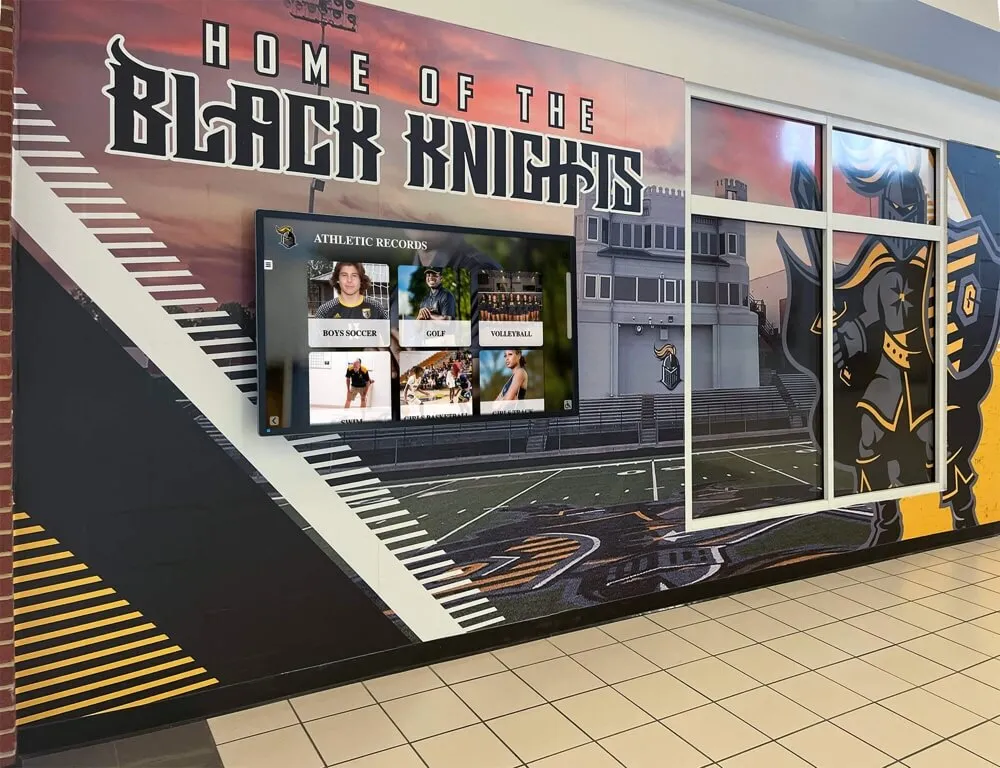
Competition recognition should include comprehensive details about achievement significance—competition scope (local, state, national), placement specifics, research or performance descriptions, and team versus individual acknowledgment. Rich storytelling helps audiences understand what students accomplished and why achievements matter within broader educational contexts.
Advanced Coursework and Academic Challenge-Seeking
Students pursuing rigorous academic programs through Advanced Placement, International Baccalaureate, dual enrollment, or honors coursework demonstrate intellectual ambition and college-readiness deserving recognition. Acknowledging challenging coursework participation validates academic risk-taking behavior schools want to encourage.
Advanced Academic Recognition:
- AP Scholar Awards: College Board designations based on AP exam performance
- Individual AP Exam Achievement: Recognition for scores of 3, 4, or 5 on specific examinations
- IB Diploma Program: Acknowledgment of full IB Diploma pursuit and successful completion
- Dual Enrollment Success: Recognition for college coursework completed while still in high school
- Honors Program Participation: Acknowledgment of sustained honors course enrollment
- Academic Distinction: Cumulative recognition for students maintaining rigorous course loads
According to the College Board, students participating in AP programs demonstrate better college outcomes including higher graduation rates and stronger first-year performance. Recognition for challenging coursework participation encourages broader student engagement with rigorous academic options that prepare students for collegiate success.
Scholarship Recognition and College Readiness
Academic scholarships represent tangible validation that scholarly excellence creates real opportunities and financial rewards. Scholarship recognition demonstrates to younger students that academic achievement matters beyond grades and school recognition—colleges and organizations provide substantial financial support for proven scholarly accomplishment.
Scholarship recognition elements should include student names and photographs creating personal connection to achievements, scholarship sponsoring organizations and award names, intended colleges or universities students will attend, academic achievement criteria that earned scholarships, and brief statements about educational aspirations or career goals. Scholarship recognition proves particularly motivational for students from families with limited college financial resources by demonstrating that academic excellence creates genuine pathways to college access regardless of family financial circumstances.
National Honor Society and Academic Organizations
Selection to prestigious academic organizations validates sustained scholarly excellence, character, leadership, and service—comprehensive achievement beyond simple academic metrics. Honor society membership recognition acknowledges holistic student development that colleges and employers value through National Honor Society membership, subject-specific honor societies for languages, mathematics, science, and social studies, academic honor societies with established selection criteria, and leadership positions held within academic organizations.
Recognition should include induction years, leadership positions held within organizations, notable service contributions, and ongoing participation demonstrating sustained commitment beyond initial membership selection. These organizational affiliations represent comprehensive student development valued throughout educational and professional careers.
Modern Technology Transforming Scholastic Recognition
Traditional recognition displays face severe limitations including physical space constraints restricting whose achievements can be shown, static bulletin boards becoming quickly outdated, and manual updating requiring significant time and resources. Modern digital recognition technology eliminates these constraints while creating more engaging and accessible recognition experiences.
Interactive Touchscreen Recognition Displays
Interactive touchscreen displays transform academic recognition from passive viewing to active exploration enabling unlimited digital space accommodating thousands of achievement records, search functionality helping students find themselves and friends, filtering by category, year, honor level, or achievement type, photo galleries bringing accomplishments to life, social sharing enabling families to celebrate digitally, web accessibility extending recognition beyond physical campus, and remote content management requiring no technical expertise.
Schools transitioning to digital recognition report 85% reduction in administrative time spent maintaining displays, while engagement metrics show students spend an average of 7.5 minutes exploring touchscreen displays compared to just 45 seconds viewing traditional bulletin boards. Solutions like Rocket Alumni Solutions provide purpose-built platforms specifically designed for school recognition, combining intuitive content management with engaging user experiences.
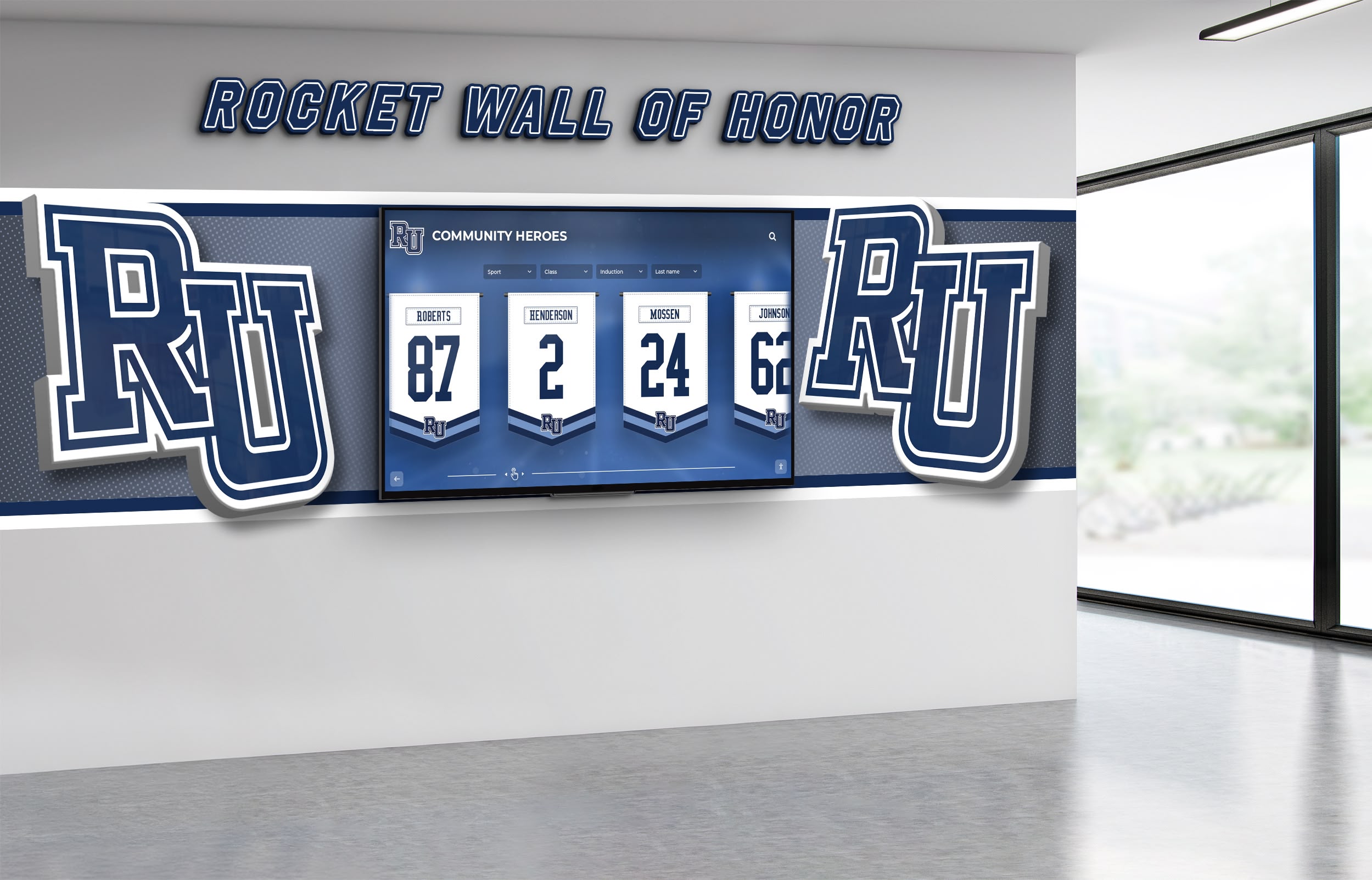
Strategic Display Placement for Maximum Impact
Recognition display location dramatically affects program impact and student engagement. Strategic placement decisions should consider traffic patterns, target audiences, and symbolic messaging about academic value.
High-Impact Placement Locations:
- Main School Entrances: Entry locations capture all daily student traffic and visitor attention
- Library and Academic Commons: Natural locations where students congregate for academic purposes
- Counseling Office Areas: Locations where students discuss academic planning and achievement goals
- Cafeteria and Student Commons: High-traffic gathering spaces providing extended viewing time
- Administrative Reception Areas: Locations frequented by visitors and prospective families
Multiple distributed displays throughout facilities often prove more effective than single concentrated installations, ensuring academic recognition maintains high visibility across entire campus rather than requiring deliberate visits to specific locations.
Content Management for Non-Technical Staff
The most sophisticated recognition technology proves useless if school staff cannot easily manage content updates without IT department dependency. Purpose-built educational recognition platforms provide intuitive content management interfaces designed for counselors, registrars, and administrative staff rather than technical specialists.
User-friendly content management features should include template-based profile creation, drag-and-drop media upload, preview capabilities before publishing, workflow approvals ensuring quality control, bulk import tools for adding multiple students simultaneously, historical archive management, and role-based permissions allowing multiple staff contributions securely. When content management feels intuitive and efficient, staff actually maintain recognition currency rather than allowing displays to become outdated.
Implementation Process: Creating Your Scholastic Wall of Honor
Moving from concept to operational recognition program requires systematic execution addressing planning, content development, technical implementation, and formal launch.
Phase 1: Strategic Planning and Objective Setting
Form Planning Committee: Assemble diverse representation including administrators providing leadership and vision, counselors offering student achievement insights, teachers from various departments providing subject-specific perspective, technology staff advising on technical requirements, parent representatives supporting community engagement, and student representatives when appropriate providing user perspective.
Establish Budget and Funding: Develop realistic financial projections covering initial hardware and software costs for digital systems, content development expenses including photography, professional design and installation services, and ongoing operation and maintenance. Identify funding sources including general education budgets, parent-teacher organization support, education foundation grants, alumni association contributions, or corporate sponsorships.
Define Timeline: Create implementation schedule accounting for planning and stakeholder engagement (2-3 months), content research and development (3-6 months), technical installation and testing (1-2 months), and formal launch and promotion (1 month). Realistic timelines prevent rushed work that compromises quality.
Phase 2: Content Strategy Development
Recognition Criteria: Establish clear, transparent standards for inclusion ensuring credibility and fairness through minimum GPA thresholds for different honor levels, cumulative versus marking period achievement calculations, attendance and conduct requirements ensuring recognition reflects overall student citizenship, and subject-specific achievement standards for departmental recognition.
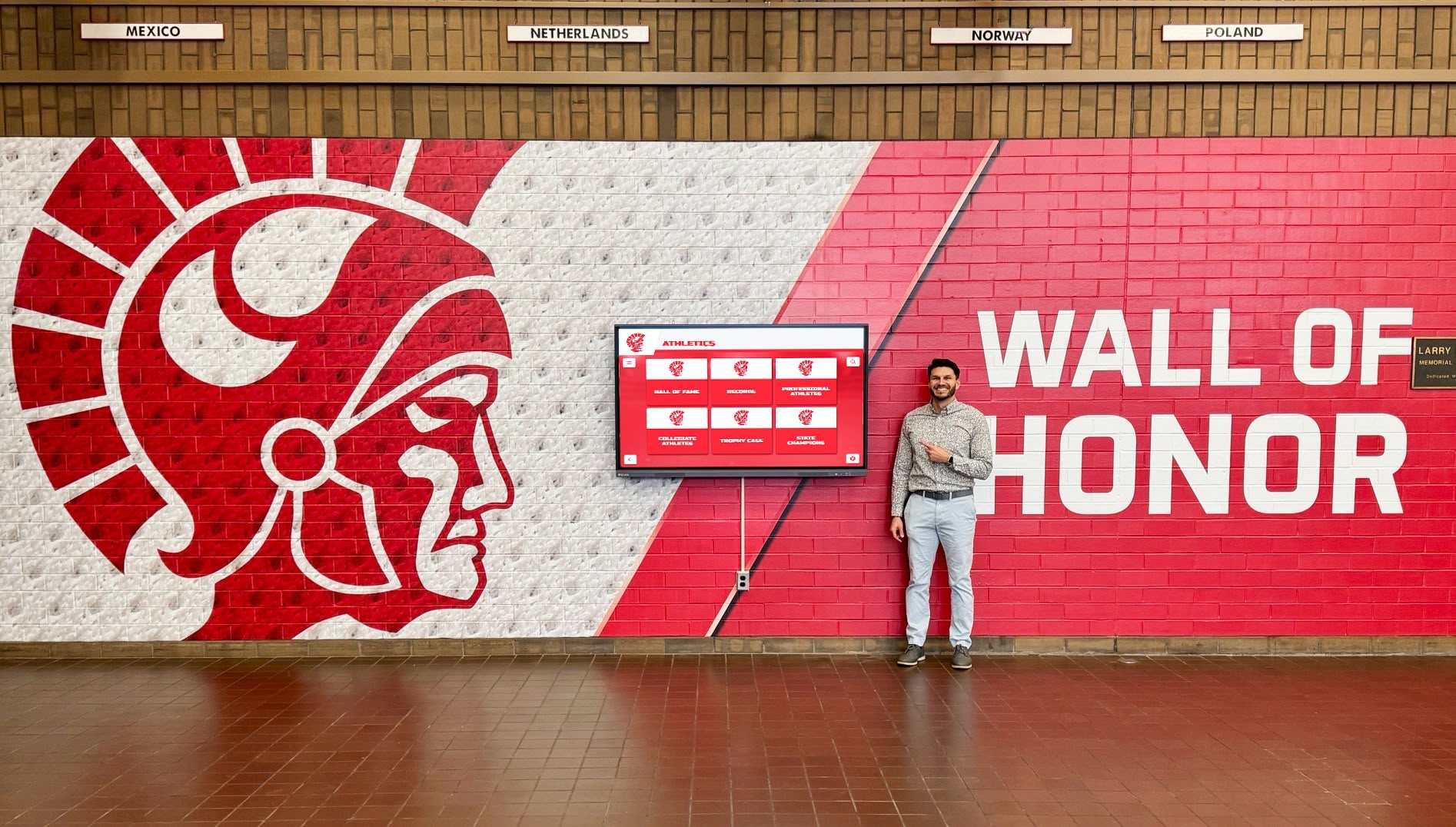
Content Collection Approach: Plan systematic processes for gathering comprehensive student information including student information system queries extracting academic data, student and family photo collection campaigns, achievement documentation connecting recognition to specific accomplishments, and quality assurance processes ensuring accuracy and appropriate tone before publication.
Phased Development: Rather than attempting complete historical documentation immediately, strategic phasing enables manageable progress. Launch with current honor roll students and recent academic achievements where information readily exists, systematically expand backward through years as resources allow, establish continuous processes for adding new students each marking period, and create periodic featured content highlighting specific achievement types or historical eras.
Guidance on content planning for digital halls of fame provides practical frameworks for sustainable, high-quality student profile creation that maintains consistency across hundreds of students.
Phase 3: Technology and Display Selection
Platform Evaluation: Assess scholastic recognition solutions against weighted criteria including content management ease for non-technical staff, user interface intuitiveness ensuring positive student experiences, total cost of ownership including licensing and support, vendor reputation and track record serving schools, scalability supporting program growth over years, and integration capabilities with existing student information systems.
Physical Placement Strategy: Location dramatically affects visibility and engagement success. Optimal placements include high-traffic areas maximizing student and visitor exposure such as main entrances, guidance counselor areas, libraries, cafeterias, and athletic facilities connecting academic recognition with athletic displays. Environmental considerations include appropriate lighting preventing screen glare, reliable power and network connectivity, comfortable viewing distances and sightlines, and accessible positioning meeting ADA requirements.
Hardware Specifications: For digital systems, ensure appropriate quality through commercial-grade displays rated for continuous operation, minimum 4K resolution for professional presentation quality, reliable multi-touch technology supporting intuitive gestures, appropriate screen size for viewing distance (typically 43"-75"), secure mounting with professional cable management, and optional features like integrated speakers for video content.
Phase 4: Launch and Ongoing Promotion
Soft Launch Testing: Limited releases before full public launch help identify issues through inviting select stakeholders for feedback sessions, comprehensively testing all functionality and content, gathering usability insights from diverse user groups, making refinements based on real-world usage, and verifying analytics tracking captures useful engagement data.
Public Launch Event: Grand openings generate awareness and establish recognition program importance through formal unveiling ceremonies with institutional leadership, recognition of inaugural honor students, invitations to recognized students and broader community, media engagement for publicity coverage, and interactive demonstrations encouraging exploration and social sharing.
Ongoing Promotion: Recognition requires sustained visibility beyond initial launches including regular communications highlighting newly recognized students, social media featuring individual student profiles and achievement stories, integration with parent conferences and school events, event-based promotion during high school reunions or homecoming weekends, and newsletter features celebrating academic excellence.
Best Practices for Sustainable Programs
Long-term success requires approaches ensuring programs remain vibrant and relevant across years and leadership transitions.
Maintaining Equitable Recognition Across All Demographics
Scholastic walls of honor risk becoming dominated by certain demographic groups unless programs proactively ensure equitable recognition distribution. Regular equity audits should periodically analyze recognition distribution across demographic groups, socioeconomic backgrounds, and programs, comparing patterns to school population demographics. If certain populations receive disproportionate recognition relative to enrollment, examine whether selection criteria inadvertently favor certain groups or whether nomination patterns reflect unequal teacher engagement.
Proportional representation should track recognition by demographic group relative to school population. Gifted programs, special education, English learners, and general education students should receive recognition opportunities proportional to their populations rather than being marginalized by narrow criteria favoring traditional academic profiles.
Ensuring Academic Integrity Standards
Comprehensive recognition acknowledges that academic excellence encompasses more than competitive achievement. Academic integrity recognition should include conduct requirements ensuring recognized students demonstrate ethical behavior, character standards requiring students embody school values, attendance requirements validating that academic success includes consistent engagement, and consideration of whole-student development beyond grades alone.
Recognition categories for exceptional academic integrity, ethical behavior in challenging academic situations, and academic honesty demonstrate that programs value how students achieve success alongside what they achieve. These categories help develop character alongside intellect during formative educational years.
Leveraging Recognition for Student Engagement
Scholastic walls of honor create natural opportunities for strengthening student engagement and building lasting motivation. Student communication approaches should notify honored students about recognition, invite participation in celebration ceremonies, share digital recognition through student and family networks, and create opportunities for students to reflect on achievement factors and strategies supporting success.
Integration with student awards recognition programs creates comprehensive frameworks celebrating achievement systematically rather than sporadically. Recognition becomes expected institutional practice rather than occasional acknowledgment, strengthening motivational impact through predictability and consistency.
Common Challenges and Proven Solutions
Schools implementing or managing scholastic walls encounter predictable obstacles that tested approaches address effectively.
Limited Space for Traditional Recognition
Many schools discover insufficient wall space for comprehensive honor roll displays accommodating all deserving students, creating impossible prioritization decisions about which students receive acknowledgment and which get excluded.
Solution Approaches:
- Transition to digital displays eliminating physical space constraints entirely
- Implement rotating recognition systems where different marking periods rotate through limited physical space while digital archives preserve complete history
- Create tiered physical recognition reserving limited space for highest honors while comprehensive digital systems recognize all achievement levels
- Strategic space reallocation ensuring academic recognition receives prominence equal to athletic recognition
Budget Constraints and Resource Limitations
Financial and staffing constraints affect implementation scope and timeline for many schools seeking to enhance academic recognition systems.
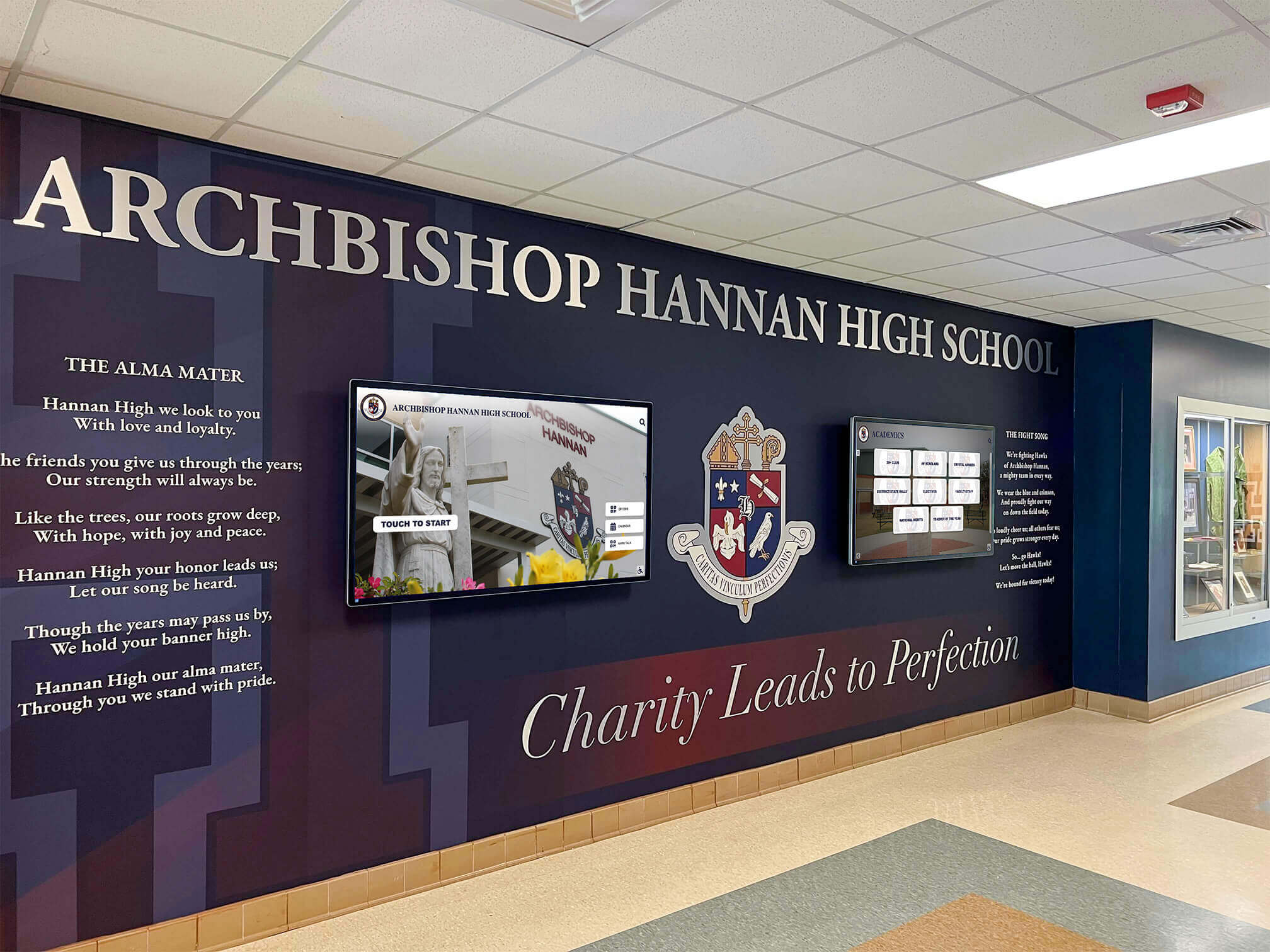
Solution Approaches:
- Phased investment strategies deploying initial core systems with planned expansion
- Creative funding through education foundations positioning recognition infrastructure as giving opportunities
- Volunteer involvement for content research, photography, or quality assurance
- Platform selection prioritizing user-friendliness minimizing ongoing technical support needs
- Long-term cost analysis demonstrating digital systems achieve parity with cumulative traditional recognition expenses
- Understanding benefits of digital asset management in school districts helps optimize content development workflows while controlling costs
Maintaining Long-Term Engagement
Initial launch excitement often fades without strategic attention to sustained relevance and fresh content. Solution approaches include regular content additions providing reasons for repeat visits, featured student rotation keeping displays fresh between major updates, event-based promotion creating periodic engagement spikes, integration with ongoing programs like college counseling or graduation ceremonies, analytics-informed optimization based on actual usage patterns, and continuous improvement mindset rather than “set and forget” implementation.
Addressing Privacy and Ethical Considerations
Thoughtful recognition programs balance public acknowledgment with respect for student preferences and privacy concerns while maintaining academic integrity.
Student Privacy and FERPA Compliance
Federal educational privacy regulations under FERPA (Family Educational Rights and Privacy Act) allow schools to publicly disclose “directory information” including honors and awards without prior consent. However, schools should establish clear privacy policies and provide opt-out mechanisms for families with legitimate privacy concerns, limit personally identifiable information beyond names and achievements, secure appropriate permissions through annual photo release forms, and clearly communicate privacy policies explaining what information gets shared publicly.
Most schools find that comprehensive communication about recognition purposes and privacy protections addresses family concerns while allowing celebration of well-deserved academic achievements.
Academic Integrity and Recognition Standards
Scholastic walls of honor must maintain credibility through consistent application of established standards regardless of external pressures. Key considerations include verifying all academic achievements through official records before recognition, establishing conduct standards ensuring recognized students demonstrate positive citizenship alongside academic excellence, maintaining transparent criteria preventing perceptions of favoritism, and establishing review processes for addressing concerns about recognition accuracy or appropriateness.
Recognition program integrity depends on consistent standards application ensuring all recognized students genuinely earned acknowledgment through academic achievement meeting established criteria.
The Future of Scholastic Recognition
Recognition technology continues evolving with emerging capabilities promising enhanced engagement and expanded applications.
Artificial Intelligence and Personalization
AI integration will enable sophisticated features improving discovery and content development including intelligent profile recommendations based on visitor interests, automated content updates from academic data systems, natural language search supporting conversational queries, and personalized experiences adapting to individual user interests and academic focus areas.
Enhanced Accessibility and Reach
Modern recognition extends beyond physical campus locations through mobile companion apps providing recognition access anywhere, virtual reality creating immersive recognition experiences accessible remotely, voice interaction enabling hands-free exploration, and augmented reality overlaying digital recognition onto physical campus environments during tours.
Comprehensive Institutional Recognition
Leading institutions expand recognition beyond honor roll to comprehensive excellence documentation including faculty and staff recognition, student leadership and service achievements, artistic and creative accomplishments, and athletic excellence alongside academic achievement—creating unified platforms celebrating all forms of institutional contribution and excellence.
Conclusion: Building Academic Culture Through Strategic Recognition
Scholastic walls of honor represent strategic investments in academic culture, student motivation, and achievement preservation. Whether schools choose traditional physical installations, modern digital interactive systems, or hybrid approaches combining both, the core objective remains constant: honoring individual academic excellence while strengthening collective scholastic culture that sustains educational mission across generations.
The most successful recognition programs share common characteristics including comprehensive coverage ensuring appropriate acknowledgment across all achievement levels, compelling storytelling bringing student dedication and resulting success to life, intuitive discovery enabling students to find personally relevant content efficiently, ongoing maintenance keeping recognition current and accurate, strategic integration with academic counseling, college preparation, and recruitment initiatives, and continuous improvement based on analytics and stakeholder feedback.
For schools beginning new recognition programs or modernizing existing systems, specialized digital recognition platforms like Rocket Alumni Solutions provide purpose-built solutions designed specifically for educational institutions. These comprehensive systems combine intuitive content management that non-technical staff can update easily, professional presentation templates ensuring consistent quality, powerful discovery tools helping visitors find relevant content, engagement analytics demonstrating program effectiveness, and reliable vendor support ensuring recognition programs achieve objectives without overwhelming institutional resources.
Beyond immediate student acknowledgment purposes, effective scholastic walls create lasting benefits including strengthening student motivation through meaningful appreciation, inspiring younger students through successful peer role models, building academic culture normalizing scholarly excellence, enhancing educational transparency demonstrating program quality, preserving institutional history celebrating achievement traditions, and supporting recruitment demonstrating academic program strength to prospective families.
Every academically successful student deserves recognition honoring their achievements appropriately. Every school deserves comprehensive tools celebrating scholarly excellence while engaging contemporary audiences effectively. Modern scholastic walls of honor—whether traditional, digital, or hybrid—make these aspirations achievable for educational institutions committed to academic excellence while building lasting student motivation across generations.
Ready to create a scholastic wall of honor that celebrates academic excellence while strengthening your educational program? Explore how Rocket Alumni Solutions delivers comprehensive recognition platforms designed specifically for schools seeking to honor students without space limitations, complex technology management, or prohibitive costs. Transform academic appreciation from temporary acknowledgment into strategic educational infrastructure supporting institutional mission for decades to come.
